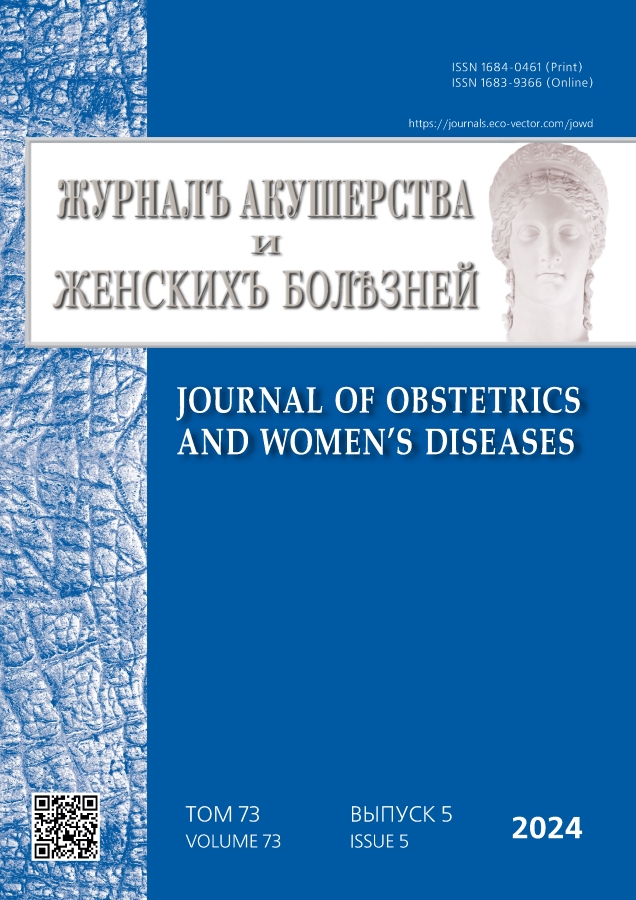Determination of antimicrobial resistance genes in patients with infected miscarriage. A rapid identification and optimized empirical therapy
- 作者: Tsechoeva L.S.1,2, Bezhenar V.F.3
-
隶属关系:
- I.I. Dzhanelidze St. Petersburg Research Institute of Emergency Medicine
- St. Petersburg State Pediatric Medical University
- Academician I.P. Pavlov First St. Petersburg State Medical University
- 期: 卷 73, 编号 5 (2024)
- 页面: 5-14
- 栏目: Original study articles
- URL: https://bakhtiniada.ru/jowd/article/view/279766
- DOI: https://doi.org/10.17816/JOWD631759
- ID: 279766
如何引用文章
详细
BACKGROUND: The infectious factor during pregnancy remains the leading cause not only of maternal mortality, but also of premature pregnancy loss and subsequent reproductive function impairment. Patients with infected miscarriage represent a special cohort in terms of complexity of clinical decision-making, while the choice of antimicrobial chemotherapy is particularly difficult in conditions of accumulation of scientific knowledge about the main microbial agents. For adequate treatment, it is essential to use all modern methods of microbiota diagnosis and conduct regular monitoring of microorganism resistance in order to update empirical schemes of antibacterial therapy.
AIM: The aim of this study was to evaluate the correlation relationship between antimicrobial resistance genes and identified microbial agents in patients with infected miscarriage in order to optimize empirical antimicrobial chemotherapy.
MATERIALS AND METHODS: We prospectively studied 42 samples of genital tract discharge in patients with infected miscarriage. The classical culture method was used to determine microorganism sensitivity to standard antibacterial drugs by the disc diffusion test. A molecular genetic study of the species composition of clinically significant microbial agents and genes of resistance to β-lactam and glycopeptide antibiotics was performed using Femoflor Screen and BakRezista GLA test systems (“DNA-Technology” LLC., Russia), respectively.
RESULTS: In the cultural study, one microbial agent was identified in 59.5% of cases, two in 40.0% of cases, and three in 7.1% of cases. The following microorganisms were most frequently identified: Enterococcus spp. in 25.0% of cases, Esherichia coli in 16.7% of cases, and Candida spp. in 11.7% of cases. During the molecular genetic study, Lactobacillus spp. were identified in 64.3% of the samples, the microorganisms associated with bacterial vaginosis in 45.3% of the samples, Candida spp. in 23.8% of the samples, and Herpesviridae family viruses in 14.3% of the samples. In 45.2% of the samples, one to 14 genes of resistance to β-lactam and glycopeptide antibiotics were identified, while Tem (19.0%), Oxa-40-like (19.0%), Stx-M1 (14.3%), Ges (14.3%), Oxa-51-like (11.9%), and Van A/B (9.5%) were most frequently determined in the samples positive for resistance genes. Comparison between phenotypic susceptibility testing and genetic prediction for antibiotics resistance demonstrated that the specificity varied from 96.4 to 100%, and the sensitivity from 40.0 to 85.7%.
CONCLUSIONS: The use of molecular genetic diagnostic methods allows for the identification of clinically significant urogenital tract infections and the detection of markers of their resistance to β-lactam antibiotics and glycopeptides in the shortest possible time. The data obtained make it possible to optimize the initial antimicrobial chemotherapy.
作者简介
Leila Tsechoeva
I.I. Dzhanelidze St. Petersburg Research Institute of Emergency Medicine; St. Petersburg State Pediatric Medical University
编辑信件的主要联系方式.
Email: doctor-leila@yandex.ru
SPIN 代码: 9248-9806
MD, Cand. Sci. (Medicine)
俄罗斯联邦, Saint Petersburg; Saint PetersburgVitaly Bezhenar
Academician I.P. Pavlov First St. Petersburg State Medical University
Email: bez-vitaliy@yandex.ru
ORCID iD: 0000-0002-7807-4929
SPIN 代码: 8626-7555
MD, Dr. Sci. (Medicine), Professor
俄罗斯联邦, Saint Petersburg参考
- Tsechoeva LS, Glushakov RI, Tapilskaya NI. An infected late miscarriage associated with a genetically determined enhanced immune response in patients with recurrent viral and bacterial infections. Gynecology. 2018;20(1):51–56. EDN: YTZPFT doi: 10.26442/2079-5696_20.1.51-56
- Tsechoeva LSh, Glushakov RI, Tapilskaya NI. Antihypoxant in complex therapy of patients with septic abortion: analysis of clinical efficacy and longterm results. Russian Journal of Human Reprotuction. 2019;25(2):105–112. EDN: YMFOYA doi: 10.17116/repro201925021105
- Quenby S, Gallos ID, Dhillon-Smith RK, et al. Miscarriage matters: the epidemiological, physical, psychological, and economic costs of early pregnancy loss. Lancet. 2021;397(10285):1658–1667. doi: 10.1016/S0140-6736(21)00682-6
- Wang H, Gu Y, Ju C, et al. Genetic characteristics and potential pathogenic agents in Campylobacter upsaliensis based on genomic analysis. Emerg Microbes Infect. 2024;13(1). doi: 10.1080/22221751.2023.2294857
- Beliaeva NR, Budilovskaya OV, Khusnutdinova TA, et al. Species composition of vaginal lactobacilli in the first, second and third trimester as a marker of pregnancy outcomes. Journal of Obstetrics and Womans Diseases. 2023;72(6):17–32. EDN: NFKZQW doi: 10.17816/JOWD585649
- Giakoumelou S, Wheelhouse N, Cuschieri K, et al. The role of infection in miscarriage. Hum Reprod Update. 2016;22(1):116–133. doi: 10.1093/humupd/dmv041
- Castanheira M, Simner PJ, Bradford PA. Extended-spectrum β-lactamases: an update on their characteristics, epidemiology and detection. JAC Antimicrob Resist. 2021; 3(3). doi: 10.1093/jacamr/dlab092
- Shipitsyna EV, Khusnutdinova TA, Goloveshkina EN, et al. Rapid urine test for bacteriuria and beta-lactam resistance in uropathogenic enterobacteria. Obstetrics and Gynecology. 2023;(2):87–97. EDN: MEDIXE doi: 10.18565/aig.2022.266
- Hecker A, Reichert M, Reuß CJ, et al. Intra-abdominal sepsis: new definitions and current clinical standards. Langenbecks Arch Surg. 2019;404(3):257–271. doi: 10.1007/s00423-019-01752-7
- Surat G, Meyer-Sautter P, Rüsch J, et al. Comparison of duration and empiric antibiotic choice of post-operative treatment in abdominal sepsis. Surg Infect (Larchmt). 2022;23(5):444–450. doi: 10.1089/sur.2021.344
- Beloborodov VB, Goloschapov OV. Gusarov VG, et al. Guidelines of the Association of Anesthesiologists-Intensivists, the Interregional Non-Governmental Organization Alliance of Clinical Chemotherapists and Microbiologists, the Interregional Association for Clinical Microbiology and Antimicrobial Chemotherapy (IACMAC), and NGO Russian Sepsis Forum “Diagnostics and antimicrobial therapy of the infections caused by multiresistant microorganisms” (update 2022). Messenger of Anesthesiology and Resuscitation. 2022;19(2):84–114. EDN: VJUOGQ doi: 10.21292/2078-5658-2022-19-2-84-114
- Priputnevich TV, Lyubasovskaya LA, Trofimov DYu, et al. Molecular genetic methods as a key-point of monitoring and diagnostics of opportunisctic infections including nosocomial among neonatal and ob-gyn patients. Obstetrics and Gynecology: News, Opinions, Training. 2020;8(1):53–60. EDN: JQWGZU doi: 10.24411/2303-9698-2020-11007
补充文件







